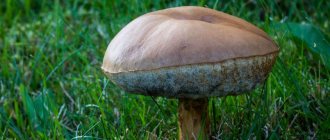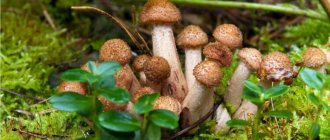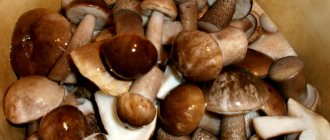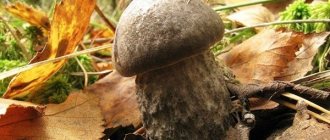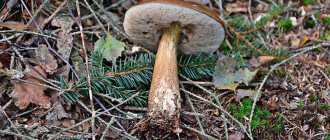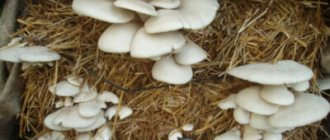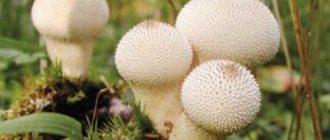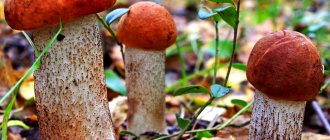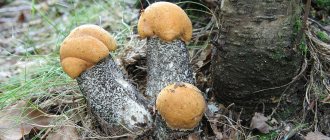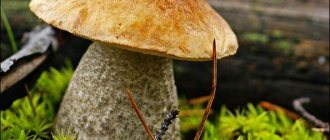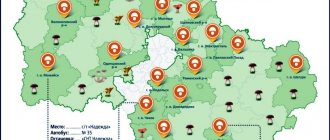Boletus mushrooms (boletus mushrooms)
Strong boletus mushrooms, close relatives of boletus mushrooms, belong to the genus Obabok and are considered mushrooms of excellent quality. As the name indicates, they are in symbiosis with birches, often developing under these trees. However, this does not always happen - various species can be found on the outskirts of swamps, in dry pine forests or in beech groves.
Main types
Common boletus (Leccinum scabrum)
Common boletus (Leccinum scabrum)
The best appearance of this group is characterized by a smooth hemispherical cap with a diameter of up to 15 cm. The skin is chestnut with a grayish, black or reddish tint; in young mushrooms it is light. The leg is up to 20 cm high, slender, wide at the base, the surface is dotted with a scaly dark pattern.
The pulp is grayish-white, then gray, does not darken when scrapped, first hard, then soft, porous. The structure is spongy in rainy weather. The taste is pleasant, the aroma is mushroom.
Swamp boletus (Leccinum holopus)
Swamp boletus (Leccinum holopus)
A tall mushroom with a very light, almost white convex cap up to 15 cm in diameter. The skin is thin, sometimes greenish or brown. The leg is long, thin, often curved, cap-colored or brownish. The tubes are whitish-cream, then brownish, turning green when pressed.
The pulp is creamy, later with a yellowish-green tint, does not darken when broken, watery, fresh in taste, with a slight mushroom aroma, often odorless.
Stiff boletus (Leccinum duriusculum)
Stiff boletus (Leccinum duriusculum)
The fleshy, robust species rarely becomes wormy, and is especially loved by mushroom pickers for this quality. The cap is up to 15 cm in diameter, hemispherical, then convex, concave in older specimens. The skin is first velvety, then smooth, matte, in wet weather - slippery, light chestnut, with a red tint, often with a lilac tint. The leg is up to 15 cm high, cylindrical, thickened in the center, cream-colored, covered with a mesh scaly pattern.
The tubes are creamy and turn greenish-brown where touched. The flesh is tight, white-cream, greenish-yellow at the stem, with a pink tint when the cap is broken, and greenish or blackened when cut at the stem itself. The taste is neutral, the aroma is pleasant, mushroom.
Boletus variegated (Leccinum variicolor)
Boletus variegated (Leccinum variicolor)
Externally and in culinary use, the species is similar to the common boletus. The cap is variegated - brown with whitish-gray spots and streaks, sometimes the main color is brown, almost black, reaches a diameter of 15 cm. The leg is brown, cylindrical, smooth, green at the base.
The tubular layer is dirty white with a bluish tint and darkens when pressed. The pulp is creamy white, when broken, it acquires a pink tint, and at the stem it turns red or green. The structure is watery, the taste is fresh, the smell is light, mushroom.
Pink boletus (Leccinum roseafractum)
Pink boletus (Leccinum roseafractum)
The hemispherical cap eventually becomes cushion-shaped and reaches a diameter of 12 cm. The skin is yellowish-brown or brown, often spotted, with light streaks. The leg is low - up to 10 cm, sometimes curved, the surface is light, with a black-brown scaly pattern.
The tubes are creamy and turn pink when pressed. The pulp is firm, light cream, turns pink when cut, and later becomes dark. The smell is insignificant, the taste is simple.
Gray boletus (hornbeam) (Leccinum carpini)
Gray boletus (hornbeam) (Leccinum carpini)
An appetizing mushroom with a round cap up to 15 cm in diameter, which is first hemispherical, then cushion-shaped, and later flat. The color of the skin is in brownish-gray tones - from light gray to brown, olive, black, yellowish in the center at the edges. The surface is velvety, at first wrinkled, then matte, cracked in hot weather, and slippery in damp weather.
The leg is tall - up to 16 cm, thick at the top, the surface is light, darkens when pressed, and is dotted with black scales, which later become brownish. The tubes are white, creamy-gray, and brown or purple when pressed.
The pulp is whitish with a yellow tone. When broken, it acquires a deep pink or red color, later turning black.
Black boletus (Leccinum melaneum)
Black boletus (Leccinum melaneum)
Squat appearance with a dark brown cap of hemispherical, then convex shape, up to 10 cm in diameter. The leg is up to 12 cm high, smooth, brown or grayish, abundantly dotted with darker scales. The skin is velvety, then matte, and sticky when damp.
The tubes are large, cream or grayish-white. The pulp is firm, white, and does not darken or turn slightly blue when cut. Mushroom aroma, neutral taste.
How to distinguish boletus from boletus?
Despite their eloquent names, these mushrooms, belonging to the same genus, can settle under aspens, and under birches, and under the canopy of many other trees.
Young mushrooms, especially light-colored species, are difficult to distinguish, and to more accurately determine the species, it is better to look for adult specimens. They are distinguished by the color of the skin, the structure and color of the pulp when broken.
In general the colors of boletus mushrooms are more modest, often in gray-brown or brown tones; boletus mushrooms are brighter - their caps are reddish-brown and orange-yellow. However, this difference is not always characteristic - the common boletus and the red boletus are similar in their chestnut-red caps, and both of these species can grow side by side.
An experienced mushroom picker will distinguish boletus by the structure of the pulp - it is more porous, loose, becomes watery with age and, when broken, does not darken or changes color slightly - often turning pink.
Boletus
Boletuses are characterized by tight flesh, which quickly turns color when cut - turns blue, purple or brown. The fruiting bodies are hard and are not destroyed by heat treatment, and therefore these species are often preferable to boletus mushrooms.
Both mushrooms are edible, have excellent quality and can be safely eaten - they are suitable for drying, pickling and any culinary delights.
Category, application of boletus
Although boletus and boletus are spoken of as mushroom brothers, boletus is still the “smaller” brother. And although it also belongs to category II mushrooms, mushroom pickers are less happy about it. But in fairness, it must be said that young boletus mushrooms with dark brown caps on thick, black-speckled legs are no worse than redcaps. It is with age that their caps become soft and flabby, but in their youth they are like two peas in a pod, similar to some varieties of boletus.
It is best to collect boletus mushrooms with a cap size of 5-6 cm. It is recommended to cut off the stem so that the stump remains no more than 2 cm from the cap.
Boletus is used fresh, fried, dried and pickled. When dried, the mushroom turns black, and therefore, like boletus, it is classified as a black mushroom. And yet, many people really like this mushroom.
Places of distribution and time of collection
Various species are common in temperate climates, in deciduous forests and parks. They live in abundance under birch trees, and it is with this tree that the titular mycorrhiza forms, the common boletus . Tight fruiting bodies are found on the edges, clearings and along forest roads. The noble mushroom does not like acidic peat soils, preferring neutral loams or calcareous soils. The collection time is long - from the end of spring until the chilly autumn and the first frosts.
In swampy lowland forests, including on peat bogs, most often under birch trees, the mycelium of boletus . These fragile mushrooms appear in whole clearings, from July until the first frost.
In deciduous and deciduous-coniferous forests, under aspen and white poplar, you can find a rather rare mushroom, the severe boletus . It prefers calcareous soils and appears singly or in small families from July to mid-October.
On the sun-warmed edges and clearings of gloomy mossy forests, under birches and poplars, variegated caps of the multi-colored boletus . The species settles in small groups or singly; collection time is from July to early autumn.
Pink boletus is found in birch groves and mixed forests . More often it settles on the outskirts of swamps, on peat soils. This stable, but rather rare species forms mycorrhiza with birch and is distributed wherever this tree grows, right up to the tundra zone. The harvest takes a short period of time - from August to early October.
Mid-summer and early autumn is the time to collect black boletus mushrooms . Places of growth - damp lowlands of birch and mixed, most often birch-pine forests, the outskirts of swamps and clearings.
gray boletus or hornbeam grows in abundance . Fruiting bodies are collected in three waves: the first - during the flowering of rowan - in early summer; the second - in July, after haymaking; the third, autumn - in September-October.
Where and when to collect boletus mushrooms?
As is clear from the name of the mushroom, boletus is associated with birch, forming with its roots a stable mycorrhiza wherever it grows - from dry forests on sand to sphagnum bogs. It is widespread throughout Russia and is also found in Central Asia. It even grows on the islands of Wrangel, Spitsbergen and Novaya Zemlya.
Most often, boletus can be found along paths and forest roads, in young forest plantations, along the outskirts of clearings and forest edges, as well as on small hills.
The three varieties of boletus differ slightly from each other in terms of growth time. The common boletus grows from June to the end of September. The swamp is found only in September. The pinkish subspecies appears in August and partially invades September.
Boletus mushrooms grow very quickly and age quickly. Already on the 6-7th day, their caps become flabby, as if pumped with water, especially if it rains at this time. The legs become fibrous and hard. And at the age of 10 days, the mushroom turns into a sponge oozing with moisture.
False species and doubles
Tubular mushrooms do not have such dangerous doubles as lamellar mushrooms. And yet, due to inexperience, the very poisonous pale grebe can be mistaken for a swamp boletus, and the real and pinkish species can be confused with a gall fungus.
Death cap
Death cap
In various deciduous forests - under birches, aspens, beeches, this most poisonous mushroom is found from July to October. The cap is first spherical, then flattened, glossy, light, sometimes with a greenish or olive tint, reaches a diameter of 10 cm. The leg is slender, without scales, with a cuff under the cap, the expanded base is hidden in a kind of pouch near the ground.
The whitish pulp is aromatic, fragile, and tastes sweet. Unlike tubular mushrooms, wide white plates are found under the cap. The species is very poisonous and even a small amount causes severe poisoning, and there is no antidote.
Bile mushroom
Bile mushroom
This species is not poisonous, but is not eaten due to its unpleasant, bitter, acrid taste. The cap is hemispherical, up to 15 cm in diameter. The skin is glossy, brownish or light chestnut. The leg is squat, thickened in the middle, with a dark mesh pattern at the top.
The pulp is very bitter, white, and turns pink when cut, reminiscent of pink boletus. In the latter, the tubular layer is creamy and turns pink only when pressed or at a break, while in the gall fungus the tubes are initially bright pink. Found in coniferous and coniferous-deciduous forests from mid-summer until frost.
Real and not so real
False boletus Forests
attract us with their bushy oak groves, shady groves and, of course, the generous gifts of mushrooms hiding in them. Many forestry experts are able to use many subtle signs to determine where tasty mushrooms are hidden in the forest, as well as distinguish edible species from inedible or poisonous ones. And this is indeed very important, since in the forests, among many representatives of the mushroom family, there are also many harmful counterparts of well-known and edible species.
This article talks about false boletuses, their characteristics and how to distinguish them from real ones.
Boletus mushrooms are highly valued for their taste and health benefits. They got their name from their predilection for growing under white birch, although they are found far from only under this tree. These mushrooms are rich in proteins, amino acids and vitamins, and in their culinary value they are only slightly inferior to boletus. The species, which is commonly called false boletus, is very similar to the real one, but does not have either its taste or the same supply of healthy substances. Sometimes, when mistakenly prepared together with its well-edible counterparts, this mushroom can spoil the taste of a mushroom dish, and, sometimes, cause intestinal disorders.
That is why information is always important about what types of real boletus mushrooms there are, how to distinguish them from a false one, what are its properties and possible harm to humans.
Beneficial features
Nutritious boletus mushrooms in dried form are close in calorie content to bread and are significantly superior to many vegetables. But unlike carbohydrate or fatty, energy-rich foods, their calorie content is determined by the presence of proteins, which are a building block of the body and must be present in the diet.
The protein composition is characterized by the presence of essential amino acids - leucine, tyrosine, arginine and glutamine, which are in an easily accessible form and are quickly absorbed.
The pulp is rich in vitamins; thiamine, nicotinic and ascorbic acids, vitamins E and D are significantly present in it. A whole complex of essential microelements - calcium and phosphorus, sodium and potassium, manganese and iron complement this wonderful natural store of valuable substances.
The fibers contained in mushroom tissues stimulate intestinal function and have a beneficial effect on digestive processes. Preparations from dried mushrooms have long been used in folk medicine for urolithiasis and inflammatory diseases of the excretory system.
These mushrooms are known to act as antioxidants, which reduce the number of free radicals and thus reduce the risk of cancer, slow down the aging process, and strengthen the immune system.
The value of boletus
In terms of value, boletus ranks second after boletus, the “king of mushrooms.” It is eaten in any form: boiled, fried, dried, pickled. Obabki are well preserved for the winter in dried or salted form. Subsequently, sauces, fillings for pies and just snacks are obtained from the preparations. It is advisable to choose young mushrooms from the forest, especially for pickling.
Boletus is a rare example of a mushroom that is useful to everyone without exception. In rare cases, one can talk about intolerance to mushroom cultures, only then it is not recommended to eat mushrooms. It brings only benefits to the rest. The dietary fiber of the pulp, entering the stomach, acts as an absorbent. They collect all harmful particles from digested food and remove them naturally. Due to the content of large amounts of potassium and phosphorus, the mushroom is useful in that it improves the functioning of the kidneys and adrenal glands, and also regulates blood sugar levels.
The benefits of obobka are as follows:
- Clears away toxins.
- Good for the skin.
- Normalizes the functioning of internal organs (liver and kidneys).
- Improves the structure of enzymes.
- Enriches with useful elements.
You can eat it while on a diet. Boletus, like any mushroom, is a good meat substitute. But it is advisable to make soups from it, less often - fry it and not eat it in salted form. An ideal option for dietary nutrition is mushroom pie, stew or boletus sauce, used as an addition to other dishes.
Contraindications
Healthy, tasty boletus mushrooms are among the best edible species, but dishes made from them should absolutely not be eaten by people suffering from gastritis, duodenal ulcers, hepatitis of any etiology, or inflammatory processes in the gallbladder.
Some people may experience individual intolerance, which is characterized by allergic reactions, and with insufficient activity of gastrointestinal enzymes, digestive problems arise, which are expressed by nausea, indigestion, and fermentation processes in the intestines.
Not recommended for consumption by people with clinical manifestations or a tendency to allergies, as well as children under seven years of age, pregnant and lactating women.
Recipes for cooking dishes and preparations
Strong mushrooms are good in a variety of dishes - in roasts and sauces, kulebyaki and pies, pickles and marinades. The beneficial properties are perfectly preserved when dried, but only young, tight specimens are suitable for these purposes; old fruiting bodies become watery and dry poorly.
Boletus mushrooms in hot marinade
This delicious, flavorful appetizer is quick to prepare and keeps well.
First of all, prepare the marinade: for 3 liters of water take 600 g of 5% vinegar, 100 g of salt, 120 g of sugar, a little citric acid, spices to taste.
Pre-cleaned mushrooms are boiled in salted water (50 g of salt per 1 liter of water), not forgetting to periodically remove the foam. As soon as the mushrooms have sunk to the bottom, they are ready, they are strained, packaged in jars and boiling marinade is poured on top. The preservation is sterilized for 50 minutes and rolled up.
Boletus mushrooms in tomato sauce
For 3 kg of the finished dish, take 1800 g of peeled and chopped mushrooms, 1 tablespoon of salt, 2 tablespoons of sugar, 1 tablespoon of 9% vinegar, 600 g of tomato paste, 600 g of water, 120 g of odorless vegetable oil, bay leaf, black peppercorns.
The fruiting bodies are cut into pieces, simmered in vegetable oil until softened, and tomato diluted with water is added. The workpiece is heated, salt, sugar, vinegar and spices are added. Mix everything thoroughly, bring to a boil and keep on low heat for 5 minutes. The mass is placed in jars, sterilized for 50 minutes and rolled up.
Boletus mushrooms with vegetables
For this healthy dish, take 1 kg of chopped fruit bodies, zucchini, squash, tomatoes, 300 g of tomato sauce, flour, vegetable oil, and spices.
Young zucchini and squash are cut into pieces, dipped in flour and fried in oil. The mushrooms are lightly blanched and fried. The tomatoes are divided into four parts and simmered until softened. All ingredients are mixed, poured with tomato sauce, salt, pepper and boiled until tender. The food is served hot or cold.
Everyone was successful with boletus mushrooms - beautiful, nutritious, tasty mushrooms, famous for their productivity and long-term fruiting. A knowledgeable mushroom picker will never be left empty-handed and, after a mushroom rain, he will easily find the stout caps under birch, hornbeam or poplar trees, notice the sturdy ones peeking out from under the leaves in swampy lowlands and on the edges of light birch groves, and will definitely fill the basket with these fragrant gifts of nature.
You will learn more about boletus mushrooms (boletus mushrooms) from the video.

